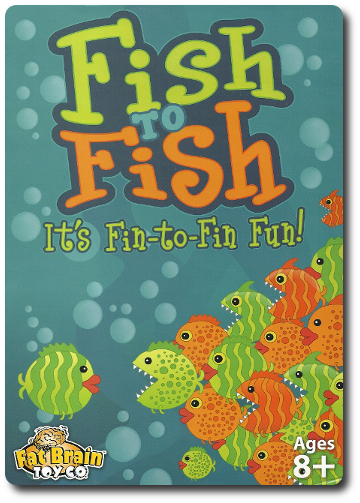
The Basics:
- For ages 4 and up (publisher suggests 8+)
- For 1 to 5 players
- Variable game play length
Geek Skills:
- Logical & Critical Decision Making
- Memorization & Pattern/Color Matching
- Reflex & Speed
Learning Curve:
- Child – Easy
- Adult – Easy
Theme & Narrative:
- Transform one fish into another as quickly and as accurately as possible
Endorsements:
- Gamer Geek approved!
- Parent Geek approved!
- Child Geek mixed!
Overview
Milton Berle said, “If evolution really works, how come mothers only have two hands?” And why do I have no hair on my head, for that matter? Regardless of your personal opinion on evolution, which some see as a theory and some as a scientific fact, two thing are for certain. Change happens and we must change to adapt. We adapt to overcome and to move forward. In this game, you will transform one fish into another, but be fast! Take too long and you’ll find that change oftentimes rolls over those who cannot adapt quickly.
Fish to Fish, designed by Nicholas Cravotta, Rebecca Bleau, and published by Fat Brain Toys, is comprised of 32 Fish tiles and 32 Fish cards. The Fish tiles are thick squares of wood and very durable. The Fish cards are made of your standard cardstock.
Game Set Up
To set up the game, shuffle the Fish tiles and deal them to the playing area, face-up, in a 6×6 grid. Fish tiles can be facing any direction. Leave the center 4×4 grid area free of tiles. All players should be able to observe and grab any Fish tile from their sitting position.
Second, shuffle the Fish cards and place them, face-down, in the center of the grid (in the empty 4×4 grid space). This is the Fish card deck.
When completed, your setup should look like the following.
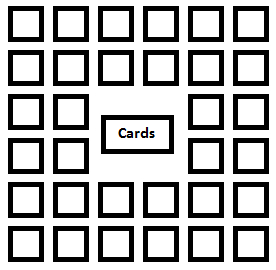
That’s it for game set up. Let’s go fishing…
Playing the Game
Fish to Fish is a Real-Time game, which means everyone plays the game at the same time. There is no turn order sequence. A game consists of 5 rounds. A single round is summarized here.
To begin the round, flip the top-most Fish card and reveal it to all the players. Two fish are shown on the Fish card. The goal for all players is to now collect Fish tiles from the grid that creates a transformation sequence that changes the fish on the left to the fish on the right (or from right to left, if the player wants).
- There is no limit to the number of Fish tiles a player can collect.
- If a player collects a Fish tile they no longer need or does not contribute to their sequence, they put it back in the grid, face-up. Any opponent can now take that Fish tile.
- Players can not take a Fish tile in front of another opponent unless it’s the VERY LAST FISH TILE they need to complete their transformation sequence.
Fish have 5 different characteristics. Specifically, fins, eyes, mouth, pattern, and color.

Each Fish tile can only transform one characteristic in the sequence. Note that players DO NOT need to claim a Fish tile that looks like the fish on the Fish cards. Only those Fish tiles that transform the fish on the left to the fish on the right are collected. There is no set minimum or maximum number of Fish tiles per transformation, but a player should only ever need a maximum of 5 Fish tiles (one per characteristic).
Let’s look at a transformation example…
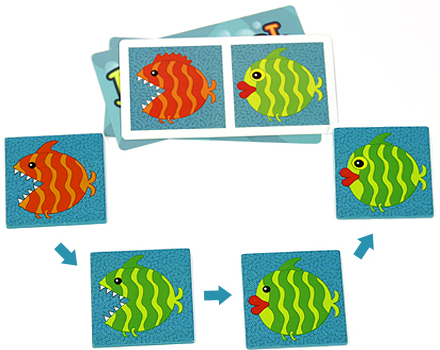
The starting fish is on the left. The player transforms it into the fish on the right by collecting 4 Fish tiles. Note that both fish share the same pattern.
- Fish Tile 1: Change fin (from wiggly to shark-like)
- Fish Tile 2: Change color (from orange to green)
- Fish Tile 3: Change mouth (from shark to pouty lipped)
- Fish Tile 4: Change eyes (from beady to highly caffeinated)
As an aside, the provided example is actually overkill. The player did not need to collect the fourth Fish tile. Remember, players do not need to collect Fish tiles represented on the Fish card. Doing so, however, does not penalize the player. Here’s another example that shows a completely different transformation sequence.
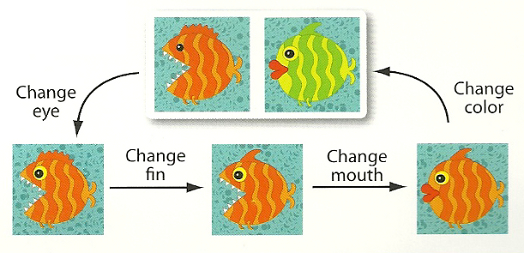
Fishy, Fishy, Fishy, Fish!
When a player completes a sequence, they shout “FISH! FISH!”. The round immediately ends and no more Fish tiles can be collected or placed back in the grid. An opponent should check the player’s sequence to determine if it’s correct. Remember: only one characteristic can change per Fish tile.
- If the sequence is correct, the player collects the Fish card.
- If the sequence is not correct, the player is out for the round! All of the player’s Fish tiles are returned to the grid and the round continues. If there is ever one player left in the round, that players wins the Fish card by default.
Note: If 2 or more players shout “FISH! FISH!” at the same time, the player who grabs the Fish card first gets the first chance to win the round. If their sequence is found to be faulty, the next player to have shouted “FISH! FISH!” gets to check their sequence and possibly win the round.
Ending the Round, Starting a New Round, and Ending the Game
If a player does complete a correct sequence, all the Fish tiles are collected, shuffled, and randomly placed back to the playing area to create a new 6×6 grid. A new round now begins as described above.
After the fifth round of play has been completed, players count the total number of Fish cards they have collected. The player with the most Fish cards wins the game.
Game Variant
The number of players suggest that Fish to Fish can be played as a solitaire game. I don’t see why not, but there is nothing in the rules to suggest how a player should go about it. I suggest something simple. For example, see how long it takes you to complete 5 rounds of game play and attempt to reduce the total amount of time in subsequent games.
House Rules
Our youngest Child Geeks could play Fish to Fish, but were not as fast as their older and more experienced opponents. This caused, as you can imagine, a great deal of woe. So as not to exclude anyone from the gaming table, we created an easy house rule. Simply let your youngest Child Geek select the first and second Fish tiles. This allows them to take their time and get a good head start on the competition. All the other players are welcome to view the tiles, but CANNOT collect any until after the youngest Child Geek collects their second tile.
To learn more about Fish to Fish, visit the game’s web page.
Prediction
This is going to be a tough game to call. At first glance, it would appear to be nothing more than a Real-Time pattern matching game. Like SET, for example. A game I am notoriously bad at, by the way.
This game is complex. Only one characteristic can be changed per Fish tile and the Fish tiles are open to any player to collect at anytime. Adding to the difficulty is the sheer number of Fish tiles to quickly review. Some of the characteristics are so subtle, that a player could pass them over without really noticing what is going on. I predict we will have a lot of players hovering over the grid, squinting at the Fish tiles in a desperate attempt to spot the characteristic they need before their opponents.
And therein lies a neat little twist to the game. While there are only 5 characteristics to change and choose from, a player can focus on any of the five they like. One player could start with the eyes and another the fin. The real goal is to collect the necessary Fish tiles to build the shortest transformation as possible. Players don’t get points for the number of Fish tiles they use. They win points by simply being the fastest.
For the Child Geeks, I think they are going to enjoy Fish to Fish, but most likely only within their peer group and with sympathetic Parent Geeks who will purposely work on their sequence a bit slower than their kids to give them a fighting chance. For the Parent Geeks, I think they are going to very much enjoy Fish to Fish. It’s casual, fun, fast, and intense. Perfect for small gatherings and dinner parties with another couple.
For the Gamer Geeks, I’m predicting mixed approval to full approval. The game does appear to be challenging, engrossing, and requires a great deal of concentration to compete. This will most likely appeal to the Gamer Geeks, if they can get over the idea that this is a family game and has silly fish all over it.
Teaching Fish to Fish is best done by pre-selecting a Fish card and pulling the necessary Fish tiles to complete a transformation sequence. Show the new players how each of the fish characteristics is changed and only one is changed per Fish tile. Make sure you let them know that there is no set number of Fish tiles they can or should use. If they can figure out the transformation is 2 Fish tile, awesome. If it takes 7 or more, just as good. Just make sure they understand that speed without accuracy will result in zero points, but not being fast will mean they won’t win the race! Note that the game does not require any reading. The only requirement is pattern matching. Unfortunately, any player who colorblind will not be able to play Fish to Fish.
And so, after teaching Fish to Fish to my 3 little geeks, I asked them their thoughts on the game so far.
“Very colorful. The game sounds easy, but I’m going to have a hard time creating a sequence.” ~ Liam (age 9)
“Sounds like a fun game, Daddy!” ~ Nyhus (age 6)
“Can we keep the fish, Daddy?” ~ Ronan (age 4)
If a player had all the time in the world and nothing pushing them to create a transformation sequence, I think Fish to Fish would be a very easy game. That is simply not the case, however. Players are going to be pushed, and when pushed, people rush and make mistakes. Let’s see how frantic a game Fish to Fish is.
Final Word
The Child Geeks both enjoyed and loathed the game. Some of the Child Geeks (specifically the older ones) liked the challenge of attempting to complete a sequence as fast as they could. There were many grunts of frustration and “Oh, no’s!” when an opponent shouted “FISH! FISH!” before they were ready. Much in the same way as a game of Bingo tends to make an entire room suddenly disgusted with the one person who ends the round. The younger Child Geeks found the game too fast and too frustrating. According to one Child Geek, “The game is too hard because everyone is pushing you to go faster than you want to.” But that was exactly what another Child Geek liked about the game. According to them, “This game can be really intense! It reminds me of a race. A race I want to win!” When all the votes were collected, Fish to Fish received mixed approval from the Child Geek group. Not that our youngest player at age 4 was able to play the game, but not nearly well enough to be competitive. I highly suggest you use the house rule we created.
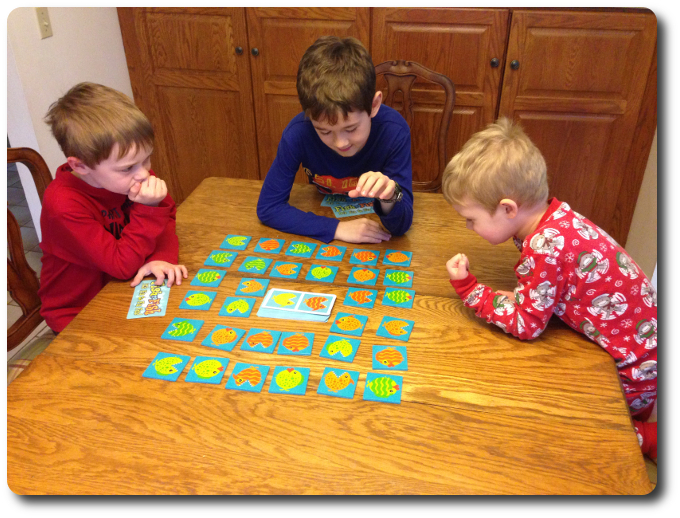
Three rounds in and still going strong! First up: my 4-year-old using the house rules
The Parent Geeks very much enjoyed Fish to Fish and were saddened when their Child Geeks didn’t like the game as much as them. According to one Parent Geek, “This is an easy game to learn how to play, but damn, it’s a hard game to win!” Another Parent Geek said, ‘You need to be fast with laser-like focus to win the game. I can be fast, but I can’t be accurate. The real challenge is finding your perfect balance and then slightly pushing yourself to be a bit faster than your opponents.” All the Parent Geeks thought Fish to Fish was a lot of fun, perfect for their peer group, and thought the game worked well with the family, but only if the family had older Child Geeks. When all the votes were collected, Fish to Fish won the Parent Geek’s approval.
The Gamer Geeks were highly dubious of my Fish to Fish pitch. All they saw at first was a “kid game” with colorful fish. According to one Gamer Geek, “This looks like Memory. I hate Memory.” But when the game was explained and the first round started, all the Gamer Geeks who were speaking negatively of Fish to Fish shut their mouths. When they suddenly realized that Fish to Fish was a game that could easily make them look slow and stupid, they gave it their full attention. Oh, you should have heard them swear up a storm when an opponent shouted “FISH! FISH!” before they were ready. When a Gamer Geek’s sequence was found to be incorrect, they shouted to the heavens in frustration and disbelief. Which, of course, is excellent. According to the same Gamer Geek who pooh-poohed Fish to Fish at the beginning, “I take it all back. This game owned me. Let’s play it again.” All the Gamer Geeks thought Fish to Fish was a very challenging and entertaining game. They thought it would be a perfect addition to their gaming table and brought out when a fast game was being asked for as a filler or simply to get the old blood pumping.
I both love and hate Fish to Fish. I love how deceptively simple it is based on the game’s design and how complex it really is when you start playing it. I hate the feeling of being rushed and KNOWING I am making mistakes. I am left with a sickening and ever-growing doubt that the sequence I am creating is both highly inefficient and incorrect. The more Fish tiles you add, the higher the odds of accidentally making a very small but painful mistake.
And therein lies the real charm of Fish to Fish. A player is never required to create a sequence using any set number of tiles. For those looking to create a sequence that is highly efficient (as in has the fewest number of Fish tiles), the challenge is attempting to scan for specifics and collecting them in a logical order. For those who just want to complete the sequence so it’s accurate, they can take as long as they like. In both cases and approaches, making a mistake is possible. Rush and you’ll slip up. Take too long and you’ll never get the Fish card.
A surprisingly entertaining, challenging, frustrating, and excellent game. Do take a look at and play Fish to Fish when the opportunity presents itself. You won’t have to “fish” for fun when playing.
Yeah, horrible pun. Sorry….
This game was given to Father Geek as a review copy. Father Geek was not paid, bribed, wined, dined, or threatened in vain hopes of influencing this review. Such is the statuesque and legendary integrity of Father Geek.




Pingback: Today in Board Games Issue #170 - D6 Dice Purse. New Cardboard Edison column! - Today in Board Games